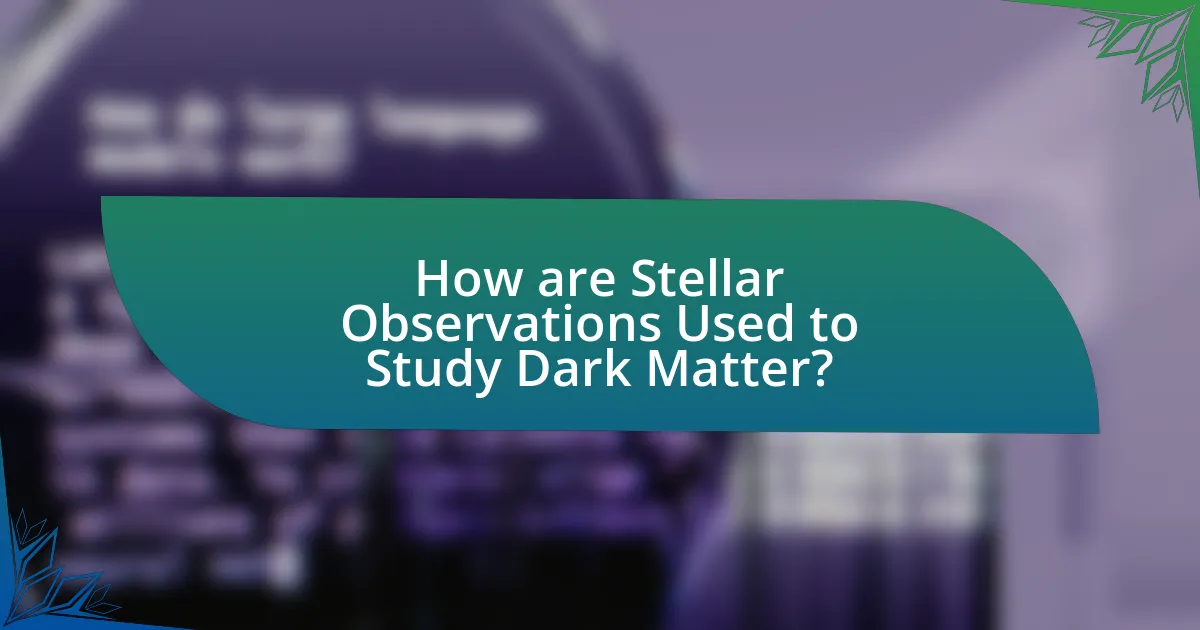Dark matter is a crucial component of the universe, constituting approximately 27% of its total mass-energy content and influencing the formation and structure of galaxies. This article explores the nature of dark matter, its gravitational effects on visible matter, and the evidence supporting its existence, including galaxy rotation curves and gravitational lensing. It also discusses the techniques astronomers use to study dark matter through stellar observations, the challenges faced in detection, and future directions for research, including upcoming space missions and collaborative efforts aimed at unraveling the mysteries surrounding dark matter.

What is Dark Matter and Why is it Important in Astronomy?
Dark matter is a form of matter that does not emit, absorb, or reflect light, making it invisible and detectable only through its gravitational effects. It is crucial in astronomy because it constitutes approximately 27% of the universe’s total mass-energy content, influencing the formation and structure of galaxies and galaxy clusters. Observations, such as the rotation curves of galaxies, reveal that visible matter alone cannot account for the gravitational forces at play, indicating the presence of dark matter. Additionally, studies of cosmic microwave background radiation provide evidence for dark matter’s role in the early universe, supporting the theory of cosmic inflation and the large-scale structure of the cosmos.
How do astronomers define dark matter?
Astronomers define dark matter as a form of matter that does not emit, absorb, or reflect light, making it invisible and detectable only through its gravitational effects on visible matter. This definition is supported by observations such as the rotation curves of galaxies, which indicate that there is more mass present than what can be accounted for by visible stars and gas. Additionally, gravitational lensing, where light from distant objects is bent by the gravitational field of dark matter, provides further evidence of its existence.
What evidence supports the existence of dark matter?
The existence of dark matter is supported by several key pieces of evidence, primarily through its gravitational effects on visible matter. Observations of galaxy rotation curves reveal that galaxies rotate at speeds that cannot be explained by the mass of visible matter alone; for instance, the outer regions of galaxies rotate at unexpectedly high velocities, indicating the presence of unseen mass. Additionally, gravitational lensing, where light from distant objects is bent around massive foreground objects, provides evidence for dark matter’s influence, as seen in the Bullet Cluster, where the distribution of mass does not align with the visible matter. Furthermore, cosmic microwave background radiation measurements show fluctuations that suggest the existence of dark matter, as detailed in studies like the Planck satellite data, which indicate that dark matter constitutes about 27% of the universe’s total mass-energy content.
How does dark matter differ from ordinary matter?
Dark matter differs from ordinary matter in that it does not interact with electromagnetic forces, meaning it does not emit, absorb, or reflect light, making it invisible and detectable only through its gravitational effects. Ordinary matter, which includes atoms and molecules, interacts with electromagnetic forces and is responsible for the formation of stars, planets, and living organisms. Evidence for dark matter’s existence comes from observations such as the rotation curves of galaxies, which indicate that there is more mass present than can be accounted for by visible matter alone, suggesting that dark matter constitutes about 27% of the universe, while ordinary matter makes up only about 5%.
What role does dark matter play in the universe’s structure?
Dark matter plays a crucial role in the universe’s structure by providing the gravitational framework that governs the formation and behavior of galaxies and galaxy clusters. This invisible substance, which constitutes about 27% of the universe’s total mass-energy content, influences the motion of visible matter through its gravitational effects. Observations of galaxy rotation curves, such as those conducted by Vera Rubin in the 1970s, reveal that galaxies rotate at speeds that cannot be explained by the visible mass alone, indicating the presence of dark matter. Additionally, gravitational lensing, observed in clusters like the Bullet Cluster, demonstrates how dark matter’s gravitational pull bends light from distant objects, further confirming its existence and role in shaping cosmic structures.
How does dark matter influence galaxy formation?
Dark matter significantly influences galaxy formation by providing the gravitational scaffolding necessary for galaxies to form and evolve. This invisible mass, which constitutes about 27% of the universe, creates gravitational wells that attract ordinary matter, leading to the clumping of gas and dust. Observations of the cosmic microwave background and galaxy clustering support the existence of dark matter, indicating that its gravitational effects are crucial in shaping the large-scale structure of the universe. Studies, such as those from the Planck satellite, have shown that the distribution of dark matter directly correlates with the formation of galaxies, as it dictates the rate at which baryonic matter can cool and condense into stars.
What is the relationship between dark matter and cosmic expansion?
Dark matter plays a crucial role in cosmic expansion by influencing the gravitational dynamics of the universe. Its presence affects the rate at which the universe expands, as dark matter contributes to the overall mass-energy content that governs cosmic evolution. Observations, such as those from the Cosmic Microwave Background radiation and galaxy cluster dynamics, indicate that dark matter constitutes approximately 27% of the universe’s total mass-energy density, which is essential for understanding the accelerated expansion observed since the late 1990s. This acceleration is attributed to dark energy, but dark matter’s gravitational effects are fundamental in shaping the structure and behavior of the universe during its expansion.

How are Stellar Observations Used to Study Dark Matter?
Stellar observations are used to study dark matter by analyzing the gravitational effects that dark matter exerts on visible matter, particularly stars within galaxies. For instance, astronomers measure the rotation curves of galaxies, which reveal that stars at the outer edges rotate faster than expected based on the visible mass alone, indicating the presence of unseen dark matter. Additionally, observations of galaxy clusters show that the mass calculated from visible matter is significantly less than the mass inferred from gravitational lensing effects, further supporting the existence of dark matter. These methods provide concrete evidence of dark matter’s influence on the structure and dynamics of the universe.
What techniques do astronomers use for stellar observations?
Astronomers use various techniques for stellar observations, including photometry, spectroscopy, and astrometry. Photometry measures the brightness of stars over time, allowing astronomers to detect variable stars and exoplanets through transit methods. Spectroscopy analyzes the light spectrum emitted or absorbed by stars, providing insights into their composition, temperature, and motion. Astrometry involves precise measurements of a star’s position and movement, which can reveal the presence of unseen companions or the effects of dark matter on stellar motion. These techniques are essential for understanding stellar properties and the broader implications of dark matter in the universe.
How do telescopes contribute to our understanding of dark matter?
Telescopes contribute to our understanding of dark matter by enabling astronomers to observe gravitational effects on visible matter, which indirectly reveals the presence of dark matter. For instance, telescopes can measure the rotation curves of galaxies, showing that stars at the outer edges rotate faster than expected based on visible mass alone, indicating the influence of unseen dark matter. Additionally, telescopes like the Hubble Space Telescope have captured images of gravitational lensing, where light from distant galaxies is bent by the gravitational field of dark matter, providing further evidence of its existence and distribution. These observations help refine models of dark matter and its role in the universe’s structure.
What is the significance of gravitational lensing in dark matter research?
Gravitational lensing is significant in dark matter research because it provides a method to observe and map the distribution of dark matter in the universe. This phenomenon occurs when massive objects, like galaxies or galaxy clusters, bend the light from objects behind them, allowing astronomers to infer the presence and amount of dark matter based on the degree of light distortion. Studies, such as those conducted by the Hubble Space Telescope, have shown that the lensing effect correlates with the mass distribution of dark matter, confirming its existence and helping to create detailed maps of dark matter in various cosmic structures.
How do stellar movements provide insights into dark matter distribution?
Stellar movements provide insights into dark matter distribution by revealing the gravitational effects of unseen mass on visible stars. Observations of stellar velocities in galaxies indicate that stars at the outer edges move faster than expected based on the visible matter alone, suggesting the presence of dark matter. For instance, the rotation curves of spiral galaxies, such as the Milky Way, show that stars maintain high speeds even far from the galactic center, which cannot be explained by the mass of stars and gas alone. This discrepancy implies that a significant amount of unseen mass, attributed to dark matter, exists in a halo surrounding galaxies, influencing stellar dynamics and supporting the existence of dark matter as a critical component of the universe’s mass-energy content.
What patterns in stellar motion indicate the presence of dark matter?
Patterns in stellar motion that indicate the presence of dark matter include the rotation curves of galaxies, which show that stars in the outer regions rotate at higher speeds than expected based on visible mass alone. This discrepancy suggests that an unseen mass, attributed to dark matter, exerts additional gravitational influence. Observations of galaxy clusters also reveal that the motion of galaxies within these clusters is influenced by a significant amount of unseen mass, further supporting the existence of dark matter. Additionally, gravitational lensing effects, where light from distant objects is bent by the gravitational field of dark matter, provide further evidence of its presence. These patterns collectively indicate that dark matter constitutes a substantial portion of the universe’s total mass.
How do simulations help in interpreting stellar observations related to dark matter?
Simulations assist in interpreting stellar observations related to dark matter by providing a controlled environment to model complex astrophysical phenomena. These simulations allow researchers to recreate the gravitational effects of dark matter on visible matter, enabling them to predict how stars and galaxies should behave under the influence of dark matter. For instance, simulations have shown that the rotation curves of galaxies, which reveal how stars move at different distances from the center, can only be accurately explained when dark matter is included in the models. This was evidenced by the work of Vera Rubin in the 1970s, where observed rotation curves deviated from predictions based solely on visible matter, leading to the conclusion that dark matter must exist to account for the discrepancies. Thus, simulations serve as a crucial tool in validating and refining our understanding of dark matter’s role in the universe.

What are the Current Challenges in Dark Matter Research?
Current challenges in dark matter research include the inability to directly detect dark matter particles, the lack of a clear theoretical framework, and discrepancies between observational data and predictions from cosmological models. Direct detection experiments, such as those using cryogenic detectors or liquid noble gases, have yet to yield conclusive results, despite extensive efforts and significant investment. Theoretical models, including supersymmetry and axion theories, struggle to provide a unified explanation for dark matter’s properties and interactions. Additionally, observations from telescopes and satellites, such as the Planck satellite, reveal inconsistencies in the distribution of dark matter, challenging existing models of galaxy formation and evolution. These challenges hinder progress in understanding the fundamental nature of dark matter and its role in the universe.
What limitations do astronomers face in detecting dark matter?
Astronomers face significant limitations in detecting dark matter primarily due to its non-interactive nature with electromagnetic forces, which makes it invisible to traditional observational methods. Dark matter does not emit, absorb, or reflect light, rendering it undetectable through standard telescopes. Additionally, the lack of direct interaction with baryonic matter complicates the identification of dark matter’s presence, as its effects can only be inferred through gravitational interactions, such as the rotation curves of galaxies and gravitational lensing. These indirect methods rely on models that can introduce uncertainties, making it challenging to ascertain the exact properties and distribution of dark matter in the universe.
How do observational biases affect dark matter studies?
Observational biases significantly impact dark matter studies by skewing the interpretation of astronomical data. These biases can arise from limitations in detection methods, such as the preferential observation of brighter or more massive objects, which may lead to an incomplete understanding of the distribution and properties of dark matter. For instance, studies like the one conducted by the Sloan Digital Sky Survey have shown that biases in galaxy surveys can result in an underestimation of dark matter in certain regions, as less luminous galaxies, which may contain substantial dark matter, are often overlooked. This misrepresentation can ultimately affect the models used to describe dark matter’s role in cosmic structure formation and evolution.
What technological advancements are needed for better dark matter detection?
Advancements in detector sensitivity, improved data analysis algorithms, and enhanced shielding techniques are essential for better dark matter detection. Increasing the sensitivity of detectors, such as those used in direct detection experiments, allows for the identification of weaker signals potentially caused by dark matter interactions. For instance, technologies like superconducting nanowire single-photon detectors (SNSPDs) have shown promise in achieving lower energy thresholds. Additionally, the development of machine learning algorithms can significantly enhance data analysis, enabling the identification of subtle patterns in large datasets that may indicate dark matter presence. Finally, advancements in shielding techniques, such as the use of advanced materials to reduce background noise from cosmic rays and other particles, are crucial for isolating dark matter signals. These technological improvements collectively contribute to more effective dark matter detection efforts.
What are the future directions for dark matter research through stellar observations?
Future directions for dark matter research through stellar observations include the utilization of advanced telescopes and observational techniques to detect the effects of dark matter on stellar motion and distribution. Upcoming projects like the Vera C. Rubin Observatory will enable large-scale surveys of the night sky, providing data on gravitational lensing and the dynamics of galaxies, which are influenced by dark matter. Additionally, the study of stellar populations in globular clusters and the Milky Way’s halo will enhance understanding of dark matter’s role in galaxy formation and evolution. These approaches are supported by the need for precise measurements of stellar velocities and distributions, which can reveal the presence and properties of dark matter through its gravitational effects.
How can upcoming space missions enhance our understanding of dark matter?
Upcoming space missions can enhance our understanding of dark matter by providing precise measurements of cosmic structures and gravitational effects. For instance, missions like the Euclid Space Telescope and the James Webb Space Telescope are designed to map the distribution of dark matter through gravitational lensing and to observe the formation of galaxies, which are influenced by dark matter. These observations will allow scientists to test theories of dark matter and refine models of cosmic evolution, as they will gather data on the large-scale structure of the universe and the behavior of galaxies in dark matter-dominated environments. The data collected will be crucial for understanding the nature of dark matter, potentially revealing whether it consists of Weakly Interacting Massive Particles (WIMPs) or other exotic candidates.
What collaborative efforts are being made in the field of dark matter research?
Collaborative efforts in dark matter research include international partnerships among various scientific institutions and observatories, such as the Large Hadron Collider at CERN, the Fermi National Accelerator Laboratory, and the European Space Agency’s Euclid mission. These collaborations aim to combine resources, expertise, and data to enhance the understanding of dark matter’s properties and its role in the universe. For instance, the Dark Energy Survey, which involves over 400 scientists from institutions across the globe, focuses on mapping the distribution of dark matter through galaxy surveys, providing critical insights into its influence on cosmic structure.
What practical steps can be taken to further explore dark matter mysteries?
To further explore dark matter mysteries, researchers can enhance observational techniques using advanced telescopes and detectors. These instruments, such as the James Webb Space Telescope and the Large Hadron Collider, can provide high-resolution data on cosmic structures and particle interactions, respectively. For instance, the James Webb Space Telescope’s ability to observe distant galaxies can help identify gravitational effects attributed to dark matter, while the Large Hadron Collider can search for potential dark matter particles through high-energy collisions. Additionally, conducting large-scale surveys of galaxy clusters and utilizing gravitational lensing techniques can yield insights into dark matter distribution and its influence on visible matter. These practical steps are supported by ongoing projects and collaborations in astrophysics, which aim to deepen our understanding of dark matter’s role in the universe.




